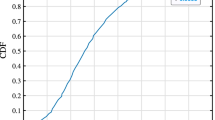Abstract
The next generation of cellular networks is expected to provide huge capacity, and site densification is one of the possible solution to increase the network capacity. The target of this paper is to show the impact of macro/micro site densification and higher order sectorization on signal strength, signal quality and throughput in LTE network. It also highlights the impact of site and sector densification on the cell overlapping and cell border areas. A detailed techno-economical analysis along with area power consumption and area spectral efficiency is also provided in this paper. In site densification, the intersite distance (ISD) between the base station sites is decreased, which results in strong inter cell interference. The results presented in this paper show that the spectral efficiency of the cell decreases with the site densification. However, the average area spectral efficiency increases due to a larger number of cells in the densified network. At the same time the number of cell border users overlapped by multiple servers also increases with the site and sector densification. It is shown that in one square kilometer, increasing the number of cells from 14 (3-sector site with 500 m ISD) to 693 (6-sector site with 100 m ISD) relatively improves the area spectral efficiency by 24.5 times at the cost of 49.5 times more number of cells. Almost identical power efficiency is provided with 3-, and 6-sector site. However, a higher order sectored site was found to be more cost efficient.












Similar content being viewed by others
References
Andrews, J. G., Buzzi, S., Wan Choi, S. V., Hanly, A., Lozano, A. K., & Soong, J. C. Zhang. (2014). What will 5G be? IEEE Journal on Selected Areas in Communications, 32(6), 1065–1082.
Osseiran, A., Boccardi, F., Braun, V., Kusume, K., Marsch, P., Maternia, M., et al. (2014). Scenarios for 5G mobile and wireless communications: The vision of the METIS project. IEEE Communications Magazine, 52(5), 26–35.
Nokia Networks. FutureWorks: Looking ahead to 5G—Building a virtual zero latency gigabit experience. 5G White Paper, p. 16. Available http://networks.nokia.com/file/28771/5g-white-paper.
Dahlman, E., Mildh, G., Parkvall, S., Peisa, J., Sachs, J., & Selén, Y. (2014). 5G radio access. Ericsson Review, 91(6), 2–7. Available: http://www.ericsson.com/res/thecompany/docs/publications/ericsson_review/2014/er-5g-radio-access.pdf.
Huawei Technologies Co., Ltd. (2013). 5G: A technology vision (Online). White Paper. Available http://www.huawei.eu/events/huaweis-5geurope-summit-2014.
Richter, F., & Fettweis, G. (2010). Cellular mobile network densification utilizing micro base stations. In IEEE International conference on communications (ICC), (pp. 1–6).
Tombaz, S., Sung, Ki Won, & Zander, J. (2012). Impact of densification on energy efficiency in wireless access networks. In IEEE globecom workshops (GC Wkshps) (pp. 57–62).
Yunas, S. F., Isotalo, T., Niemelä, J., & Valkama, M. (2013). Impact of macrocellular network densificationon the capacity, energy and cost efficiency in dense urban environment. International Journal of Wireless and Mobile Networks (IJWMN), 5(5), 99–118.
Hiltunen, K. (2012). Total power consumption of different network densification alternatives. In IEEE 23rd international symposium on personal indoor and mobile radio communications (PIMRC) (pp. 1401–1405).
Bhushan, N., Junyi, Li, Malladi, D., Gilmore, R., Brenner, D., Damnjanovic, A., et al. (2014). Network densification: The dominant theme for wireless evolution into 5G. IEEE Communications Magazine, 52(2), 82–89.
Johnson, C. (2012). Long term evolution in bullets (2nd ed.). Northampton: Johnson.
Holma, H., & Toskala, A. (2009). LTE for UMTS—OFDMA and SC-FDMA based radio access. Chippenham: Wiley.
Sheikh, M. U., Lempiäinen, J., & Ahnlund, H. (2013). Advanced antenna techniques and higher order sectorization with novel network tessellation for enhancing macro cell capacity in DC-HSDPA network. International Journal of Wireless and Mobile Networks, 5(5), 65–84.
Laiho, J., Wacker, A., & Novosad, T. (2006). Radio network planning and optimization for UMTS (2nd ed.). Chichester: Wiley.
Itkonen, J., Tuzson, B.P., & Lempiäinen, J. (2006). Performance analysis of CDMA cellular networks based on alternative hexagonal network layouts. In IEEE 17th international symposium on personal, indoor and mobile radio communications, 2006 (pp. 1–5).
3GPP, E-UTRA and E-UTRAN Overall description: Stage 2 (Release 8), 3GPP TS 36.300 V8.0.0, Apr. 2007. Available September, 2014, http://www.3gpp.org.
3GPP, E-UTRA and E-UTRAN Overall description: Stage 2 (Release 10), 3GPP TS 36.300 V10.2.0, Dec. 2010. Available September, 2014, http://www.3gpp.org.
3GPP, E-UTRA and E-UTRAN Overall description: Stage 2 (Release 10), 3GPP TS 36.300 V11.3.0, Dec. 2012. Available September, 2014, http://www.3gpp.org.
Jungnickel, V., Manolakis, K., Zirwas, W., Panzner, B., Braun, V., Lossow, M., et al. (2014). The role of small cells, coordinated multipoint, and massive MIMO in 5G. IEEE Communications Magazine, 52(5), 44–51.
Zhang, X., & Haenggi, M. (2014). A stochastic geometry analysis of inter-cell interference coordination and intra-cell diversity. IEEE Transactions on Wireless Communications, 13(12), 6655–6669.
Shannon, C. (1949). Communication in the presence of noise. Proceedings of the IRE, 37(1), 10–21.
Alouni, M., & Goldsmith, A. (1999). Area spectral efficiency of cellular mobile radio systems. IEEE Transactions on Vehicular Technology, 48(4), 1047–1066.
Yunas, S.F., Niemela, J., Valkama, M., & Isotalo, T. (2014). Techno-economical analysis and comparison of legacy and ultra-dense small cell networks. In IEEE 39th conference on local computer networks workshops (LCN workshops), 2014, (pp. 768-776), September, 8–11.
Hossain, M.M.A., Koufus, K., & Janti, R. (2013). Energy efficient deployment of HetNets: Impact of power amplifier and delay. In Proceedings of the IEEE wireless communications and networking conference.
Acknowledgements
The authors would like to thank European Communications Engineering (ECE) Ltd and European Celtic-Plus project SHARING for supporting this research work.
Author information
Authors and Affiliations
Corresponding author
Appendix
Appendix
Rights and permissions
About this article
Cite this article
Sheikh, M.U., Säe, J. & Lempiäinen, J. In preparation towards future cellular networks: the detailed analysis of macro and micro site densification and sector densification. Telecommun Syst 65, 621–636 (2017). https://doi.org/10.1007/s11235-016-0255-2
Published:
Issue Date:
DOI: https://doi.org/10.1007/s11235-016-0255-2








